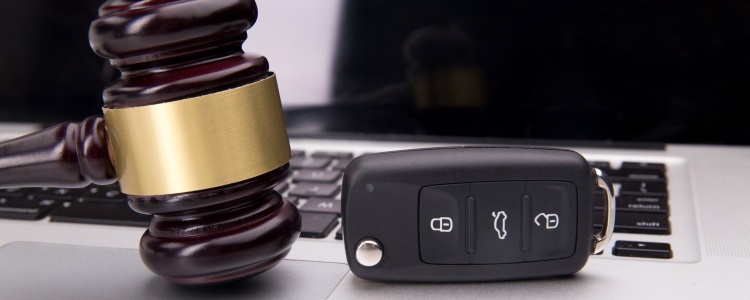Filing for bankruptcy is something that most people would rather avoid. It may be a necessary last resort when you can no longer handle your debts, but once you file for bankruptcy, it can be difficult to get financing for something expensive like a car.
No matter which type of bankruptcy you file, there’s one common step you need to take before you can even attempt to buy a vehicle during bankruptcy: getting permission from the court.
Bankruptcy Trustees
 According to the legal experts at Nolo.com, a trustee is appointed to every bankruptcy case. A bankruptcy trustee is the go-to source for all things related to your bankruptcy once you file, and acts as the go-between for the court.
According to the legal experts at Nolo.com, a trustee is appointed to every bankruptcy case. A bankruptcy trustee is the go-to source for all things related to your bankruptcy once you file, and acts as the go-between for the court.
Trustees play different roles in different types of bankruptcies. But, no matter if you file a Chapter 7 or Chapter 13, your trustee's job is to examine the paperwork before filing, and to carefully go over anything relevant to your particular bankruptcy.
Trustees are paid by the court, but how willing they are to get involved or to answer any specific questions you may have is going to depend on the trustee.
Trustees in Chapter 7 Bankruptcy
Once you file a Chapter 7 bankruptcy, it’s the trustee’s job to oversee the case, ensure your paperwork is accurate, and sell any property you can't keep in order to repay your creditors. In the case of a Chapter 7, your trustee gets a small percentage of any assets sold, but they have to be fair to you – the debtor – in all transactions.
It's also the trustee’s job to ensure that the information on your petition for bankruptcy is accurate. They do this by examining the documents you provide that prove the information you gave is correct, such as check stubs, bank records, and tax returns.
About a month after filing, you attend a meeting in front of your bankruptcy trustee called a 341 meeting of creditors. During this meeting, which creditors may attend, you have to answer questions about the information you provided in your paperwork while under oath.
Following the 341 meeting, it's now the trustee's job to sell your nonexempt property and divide the profits among your creditors. All of this happens in a very short time frame – typically four to six months.
Because a Chapter 7 bankruptcy doesn't last long, it can be difficult to get an auto loan during this process. The biggest obstacle to getting a vehicle during Chapter 7 is that the value of your car could be greater than the exemption limit for your state, and therefore could be included as an asset to be sold by your trustee. If this happened, the lender would be forced to charge off most of the loan balance.
Trustees in Chapter 13 Bankruptcy
The trustee's role in a Chapter 13 bankruptcy is very similar to that of a Chapter 7. The major difference is that instead of selling your property in order to pay your creditors, the trustee oversees a repayment plan which allows you to pay all, or much of what, you owe to your creditors over a three- or five-year period.
Your trustee again reviews your paperwork, and assesses the repayment plan, ensuring it's in line with current bankruptcy laws in your state. During the course of your Chapter 13 bankruptcy, the trustee is responsible for collecting and distributing your payments.
Like a Chapter 7, you're required to attend a meeting of creditors, but it's called a Chapter 13 meeting of creditors instead of a 341 meeting. If a creditor finds a problem with the proposed repayment plan, the trustee must then attend a confirmation hearing to tell the judge why they feel the plan meets all the necessary requirements.
You're required to begin sending payments to your trustee within 30 days of filing the bankruptcy. Until the plan is approved by the court, it's the trustee's job to collect your payments until they can be distributed to your creditors.
Because a Chapter 13 is such a long process, there's an option in place that allows you to finance a vehicle during one. Unlike in a Chapter 7, where a car is in danger of being sold as an asset, financing during a Chapter 13 only requires that your loan be repaid without affecting your current repayment plan.
That's why, when you purchase a vehicle during a Chapter 13, you must get a sample buyer's order from a special finance dealership that has lenders that offer bankruptcy financing. This sample buyer's order then gets submitted to your trustee so they can begin the process of getting court approval. This can take some time, and you're unable to complete the financing process until the court gives its approval.
Finding Bankruptcy Auto Loans
Before you decide to get a car during a bankruptcy, make sure you check with your trustee. We're not lawyers, so if you're ever in doubt about any procedure regarding bankruptcy and car buying, you should always consult one.
At the same time, if you need a vehicle and you're in or have been through a Chapter 7 or Chapter 13 bankruptcy, you have to go through the right kind of lender. Typically, this means going through a subprime lender. These lenders have the ability to work with people in many different credit situations, including bankruptcy, and they work exclusively through special finance dealers.
Here at Auto Credit Express, we work with a nationwide network of these dealerships and have been helping match borrowers in need with them for over 20 years. Let us help you get connected to a dealer near you by filling out our easy auto loan request form now.
















